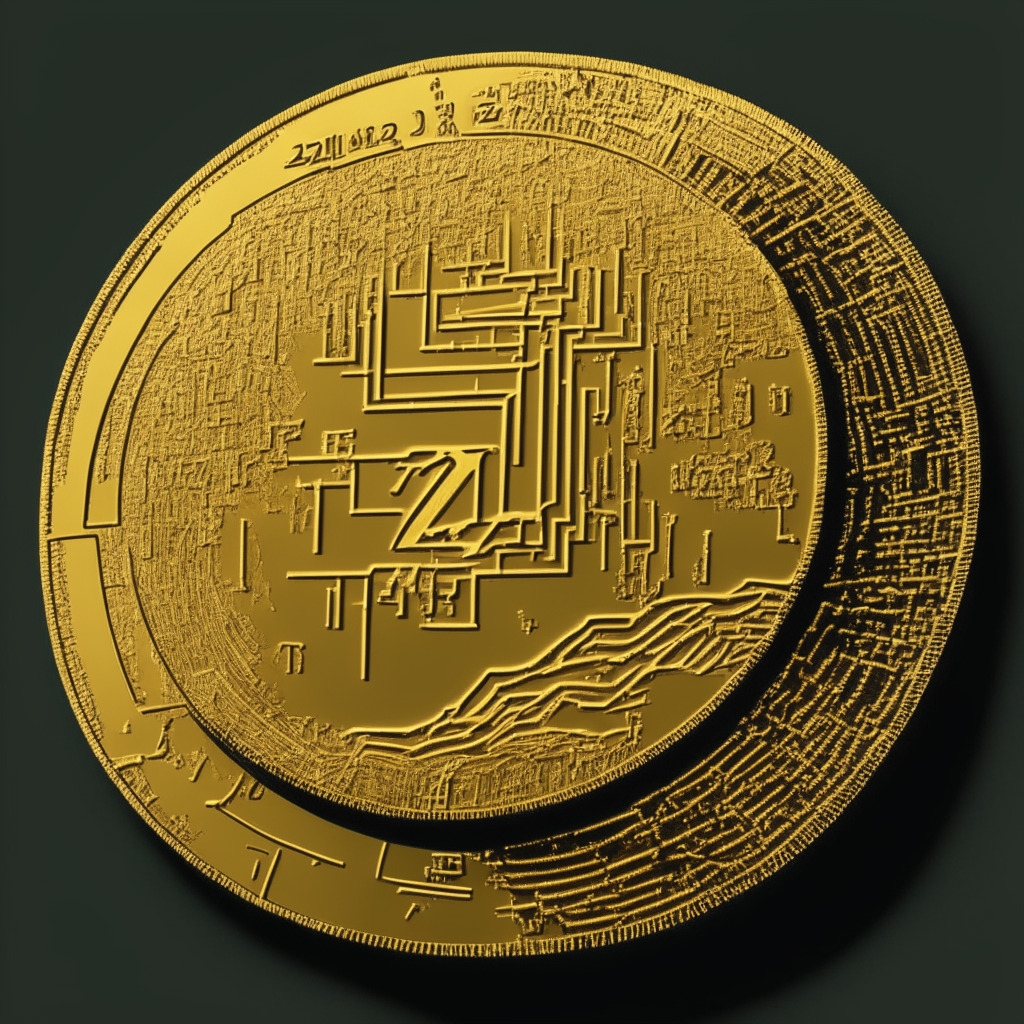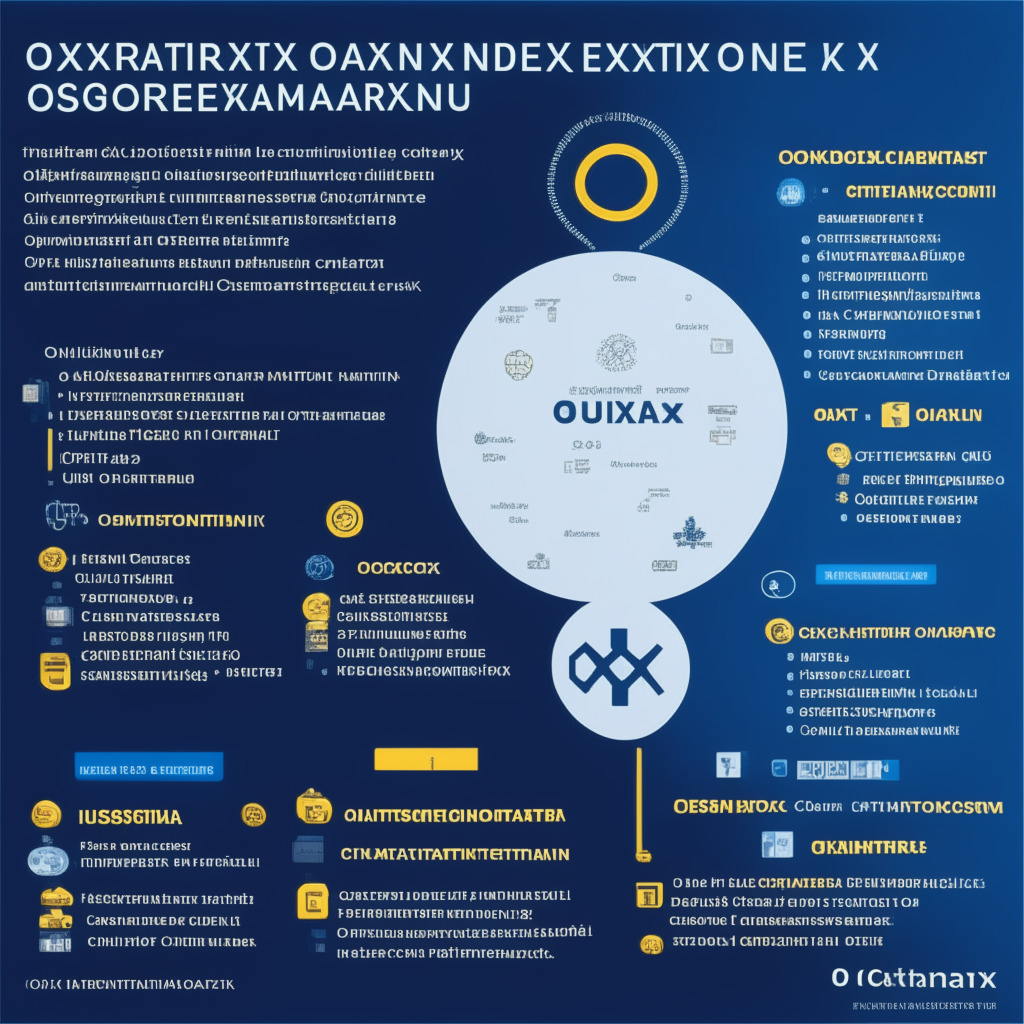“Backed Finance has launched the world’s first tokenized government bond on the Base network, marked as blB01. This innovative move provides investors with a way to monitor the value of the asset without direct exposure. However, due to unclear regulations, it remains inaccessible to U.S. investors.”
Search Results for: Backed Finance
Unwrapping the Saga of Alameda’s USDT Mints & Zimbabwe’s Gold-Backed ZiG Tokens
“Alameda Research has minted over $38 billion in Tether (USDT) tokens in 2021, indicating that the total value of USDT creation surpasses Alameda’s total assets. The inner workings of this process involve benefiting from trade value discrepancies and ensuring USDT’s dollar peg stability. However, this raises ethical concerns for industry watchers.”
Navigating the Waters of Real-World Asset Tokenization: Insights from Backed’s Latest Launch
“Swiss entity Backed has launched its latest product, bIB01, on the Base blockchain, offering a digital engagement tool for traditional finance enthusiasts. Backed’s tokenized securities, or bTokens, represent real-world assets like corporate bond ETFs and treasury ETFs. Despite limitations for US-based investors, this marks an intriguing merger of traditional assets with digital technology.”
Reshaping Crypto Landscape: Impact and Prospects of U.S. SEC-backed Ethereum ETFs
“The Ethereum ETFs’ approval by the U.S. Securities and Exchange Commission symbolizes a crucial regulatory progression, and, despite low initial trading volumes, it opens the door for crypto market expansion. However, investor preferences and wavering organizational confidence could influence the ETFs’ success trajectory.”
Decoding the Maze: Blockchain Finance, Sanctions and the Eternal Cat-and-Mouse Game
The US Department of Treasury has imposed sanctions on an Ethereum-backed cryptocurrency wallet linked to an international drug trafficking organization, highlighting renewed governmental attention towards illicit activities facilitated via blockchain. This saga exposes pitfalls and successes in the fight for blockchain transparency and safety.
Straddling Digital and Traditional Finance: Zodia Custody’s Expansion and the Regulatory Dance
“Zodia Custody, a subsidiary of Standard Chartered, now offers digital asset custody services in Singapore, anticipating growing investment as regulations evolve. This move, along with its current registrations in U.K., Ireland, Luxembourg, and a pending application in Japan, signifies its global ambitions in the cryptocurrency sphere. Balancing regulatory respect, innovation, and stakeholder interests is crucial.”
Decoding yPredict’s Fusion of AI and Traditional Finance: A Promising Leap or Elaborate Hype?
yPredict successfully secured $3.66 million for its native token, $YPRED, bridging traditional statistics and AI to offer unprecedented trading insights. Not exclusive to experts, yPredict democratizes data science with a subscription-based Prediction Marketplace, disrupting hedge funds’ hold on quantitative analysis and promoting wider access to data-backed trading strategies.
AI in Cryptocurrency: The Oracle of Modern Finance or a Risky Bet?
“The financial sector is embracing AI crypto platforms like yPredict for accurate forecasting of volatile cryptocurrency markets using science-backed algorithms and machine learning. However, investments in such technologies carry inherent risks. yPredict’s offerings include a prediction marketplace and analytical tools using the ARIMA model and LSTM tool for accurate price forecasts.”
Maple Finance’s $5 Million Expansion into the Asian Crypto Market: Innovation or Risk?
“Maple Finance, a blockchain-based credit marketplace, has revealed plans to expand into the Asian market, supported by a $5 million investment from firms including BlockTower Capital and Tioga Capital. This move forms part of a growth strategy to extend its technology and create global alliances, primarily within Singapore, Japan, Hong Kong, and Korea.”
Morpheus: Microsoft and LeverFi’s AI Game-changer in Decentralized Finance World
“Microsoft and LeverFi are developing ‘Morpheus’, an AI assistant for portfolio management in the DeFi space. The tech incorporates two AI engines addressing protocol security and market failure, aiming to minimize portfolio losses while enhancing user confidence and control.”
Exploring Crypto-Backed Mortgages: The Future Fusion of Blockchain and Real Estate
“Crypto-backed mortgages, secured by cryptocurrencies like Bitcoin and Ethereum, offer a new way of accessing loans. These transactions use blockchain technology and smart contracts to ensure safety and transparency. Yet, market volatility and security breaches pose potential challenges.”
Tokenizing Ghana’s Commodities: A Blockchain-Backed Path to Prosperity or a Fear-Induced Stalemate?
“Tokenization of commodities like gold, cocoa, and oil through blockchain could transform economies of African nations such as Ghana. This process would reduce transaction fees, amplify revenue, and open new trading avenues. However, hesitation in adopting and integrating crypto technologies in regulatory frameworks remains a significant obstacle.”
Saddle Finance Shutdown: A Portentous Shift in Blockchain dynamics or a Necessary Precaution?
“The recent announcement of Saddle Finance, an Ethereum-based crypto trading protocol, to cease operations and disburse its treasury to its investors, paints an intriguing picture of the changes in the blockchain space. This incident, following a major hack on Curve, serves as a stark reminder of the ever-present threat of exploitable bugs in the blockchain universe, and stresses the importance of investor vigilance.”
Decentralized Finance’s Future: Evaluating the Potential and Challenges of Velvet Capital
“Emerging from obscurity, DeFi is gaining influence in finance as enterprises and individuals pivot from centralized bodies to decentralized alternatives. Velvet Capital, backed by Binance Labs, offers on-chain digital asset management. Yet, concerns linger about security risks and skepticism towards its approach remains.”
DeFi Security Scare: The $61 Million Curve Finance Breach Study
A recent exploit targeting the Curve Finance pools via the Vyper programming language led to a $61 million theft, exposing DeFi vulnerabilities. This event has sparked discussions about security in the blockchain era and emphasized the need for continuous investment in safety protocols. Despite losses, it also presents an opportunity for DeFi platforms to refine and rebuild.
Curve Finance Hack and the Tentative Balance in DeFi’s Future
“The DeFi segment suffered a setback when Curve Finance, an Ethereum-based decentralized exchange, was hacked, leading to a 20% price drop in its token (CRV). Founder Micheal Egorov’s substantial loans backed by CRV triggered a panic-induced price drop. However, Egorov’s partial loan repayments and an intriguing pattern in the derivatives market suggest a potential near-term rally for CRV.”
The Bahamas to Disrupt Traditional Cross-Border Payments with USDC-Backed Wallet
“Island Pay, a Bahamian fintech firm, launches a digital wallet named CiNKO, leveraging the USDC stablecoin for financial inclusion. Unlike volatile cryptocurrencies, USDC provides stability, thereby reducing costs in cross-border transactions and greatly aiding the remittance landscape in Latin America.”
Regulatory Uncertainty, DeFi Accountability, and Cryptocurrency-backed Dollar: A Crypto Crossroads
Regulation discussions remain a pressing issue in the cryptocurrency space. With the SEC undecided on Ripple’s ruling, a newly-introduced U.S Senate bill targeting decentralized finance (DeFi), and proposals of Bitcoin being utilized to strengthen the U.S dollar, the future of cryptocurrency is fascinatingly unpredictable.
Unlocking Liquidity with Luxury: A Look at NFT-backed Loans in DeFi Sector
A decentralized finance borrower used a Non-fungible Token (NFT) backed by a luxury watch as collateral for a $35,000 loan. This innovative lending practice offers anonymity and access to global liquidity but adds an element of centralization. Critics question the necessity of NFTs in the process. This approach is forging a new pathway in the world of digital financing.
Exploring Project Guardian: Tokenized Digital Assets and the Future of Finance
The Monetary Authority of Singapore, Bank for International Settlements, and major financial institutions collaborate on Project Guardian, which explores designing open and interoperable networks for tokenized digital assets across asset classes like wealth management, fixed income, and foreign exchange. This project raises questions on accessibility, scalability, and regulatory adaptation.
BRICS Gold-Backed Digital Currency: Boon or Global Economic Game Changer?
The upcoming BRICS Summit in 2023 may unveil a gold-backed digital currency to enhance financial independence for Brazil, Russia, India, China, and South Africa, reducing reliance on existing monetary systems like the US Dollar. This unified digital currency could increase investment, growth, trade, and cooperation within BRICS, benefiting the global economy and potentially reducing the dominance of the US Dollar and euro.
SAP Tests USDC for Cross-Border Payments: A Glimpse into Blockchain’s Future in Finance
German software giant SAP plans to utilize the US Dollar Coin (USDC) for testing cross-border payments, aiming to resolve complications faced by SMEs. If successful, this could lead to increased Ethereum-based cryptocurrency adoption and highlight the potential of decentralized finance (DeFi) in the payments industry.
Valkyrie Bitcoin Fund: Bridging Traditional and Crypto Finance – Pros, Cons, and Conflicts
Valkyrie Digital Assets updated its filing for the Valkyrie Bitcoin Fund, aiming to provide investors an affordable way to invest in Bitcoin. The fund would reflect the price of CME CF Bitcoin Reference Rate – New York Variant (BRRNY). Valkyrie’s potential success hinges on overcoming regulatory challenges and market sentiment.
Bitcoin’s 8% Gain Amid Major Finance Firms Entering Crypto: Boon or Bane for Investors?
The cryptocurrency market has surged with Bitcoin’s price reaching $28,800 as traditional finance firms enter the crypto space. Deutsche Bank applied for a digital asset custody license, while EDX Markets’ trading support for cryptocurrencies expanded. Invesco also reapplied for a spot bitcoin ETF, emphasizing investor protection. However, skepticism remains regarding investor protection and the impact of traditional finance firms in the crypto market.
Bitcoin Dominance Rises, Aave’s Growth, and DeFi’s Impact on Traditional Finance
Crypto majors such as Bitcoin and Ether experience a price surge, with Bitcoin reclaiming 50% market share amidst regulatory complexity. Aave’s v3 platform sees its total value locked rise by 15%, as DeFi protocols gain traction due to declining confidence in traditional finance.
EDX Markets: A Game Changer for Crypto, Traditional Finance Giants Enter the Fray
EDX Markets, a digital asset market backed by Fidelity Digital Assets, Charles Schwab, and Citadel Securities, aims to bring competition, transparency, fairness, and safety to the crypto space. Unlike other exchanges, EDX Markets doesn’t custody customer assets and requires users to rely on financial intermediaries, appealing to regulators.
Finance Giants Enter Crypto: EDX Markets’ Regulated Approach vs Innovation Potential
EDX Markets, a crypto exchange backed by major finance players, recently launched targeting institutional investors. With close collaboration with US securities regulators, it avoids regulatory hurdles and takes a cautious approach by offering only four cryptocurrencies – Bitcoin, Ether, Litecoin, and Bitcoin Cash – for trading. The platform’s focus on regulation may impact innovation potential in the crypto world.
OKX and Komainu Partnership: Bridging Crypto and Traditional Finance, But at What Cost?
OKX partners with digital asset storage firm, Komainu, to offer institutional users secure cryptocurrency storage and trading. This collaboration aims to create a vertically integrated system, minimizing the risk of catastrophic events while bridging the gap between traditional finance and crypto exchanges. However, concerns regarding centralization and privacy emerge with Komainu’s access to sensitive client data.
Solana-based Marinade vs. Lybra Finance: Analyzing the Future of DeFi 2.0 and Staking Coins
The Solana-based Marinade ($MNDE) coin experienced a 160% increase this weekend, while Lybra Finance ($LBR) saw a dramatic retrace after hitting an all-time high. As part of the DeFi 2.0 trend, developments in stETH could impact both coins’ future value.
Japan’s MUFG Unveils Progmat Coin: A New Era for Bank-Backed Stablecoins & Cross-Chain Solutions
Japan’s MUFG unveils Progmat Coin, a stablecoin issuance platform supporting local bank-backed stablecoins on multiple public blockchains. The platform aims to provide a universal digital asset payment method for stablecoins, cryptocurrencies, and a Japanese CBDC while addressing potential security concerns.
Tokenization Revolution: Taurus, Polygon & the Future of Mainstream Finance
The partnership between Swiss digital asset infrastructure provider Taurus and Ethereum scaling network Polygon highlights the growing traction of blockchain technology and tokenization within mainstream finance. With numerous financial institutions seeking blockchain-agnostic and token-agnostic infrastructure, the landscape will continue to evolve, attracting players from various sectors and revolutionizing asset management solutions while addressing security, scalability, and compliance concerns.
Amex’s AI Partnerships: A Future of Streamlined Finance or Controversial Practices?
American Express (Amex) plans to extend its AI capabilities through partnerships for validating transactions, approving credit lines, analyzing customer sentiment, and predicting finances, without creating its own large language model. The company aims to integrate AI into various activities and services while maintaining a cautious approach to incorporating the latest generation of AI technologies.































